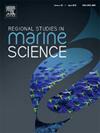Interactive effects of Lugol concentrations and soaking durations on physiology of fragment of soft coral, Sarcophyton serenei (Tixier-Durivault, 1958)
IF 2.1
4区 环境科学与生态学
Q3 ECOLOGY
引用次数: 0
Abstract
The study investigated the impact of four Lugol concentrations and four soaking times on the self-attachment time of fragmental soft coral S. serenei. After fragmentation and soaking, the coral was cultured for 30 days with six replicates for each treatment. After 30 days of culture, the results indicated that the fastest self-attachment time was observed in treatment with 0.5 mL.L−1 Lugol and soaked for 15 minutes, while the time until complete healing was in treatment without Lugol and soaked for 10 minutes. The Lugol concentration, soaking time, or their interaction did not significantly influence the growth rate, with the exception of the Lugol concentration, which significantly impacted the coral's growth in length. The study found that survival rates were highest in treatments with 0.5 mL.L−1 Lugol and soaked for 15 minutes and 1.0 mL.L−1 Lugol and soaked for 10 min, with a survival rate of 85.00 %. The lowest survival rate (71.67 %) was observed in treatments without Lugol and soaked for 20 minutes and 1.5 mL. L−1 Lugol for 20 min. Mortalities were observed until day 9, and no further deaths were recorded until the end of the study period. The experiment showed high chlorophyll a and zooxanthellae concentrations in the coral at the start, with no significant differences among the treatments. On days 3 and 6, the chlorophyll a content and zooxanthellae decreased, but showed a slight recovered on day 9 and showed a slight higher than Chl-a and zooxanthallae in coral at initial. The Lugol concentration, soaking time, and their interaction did not significantly affect the chlorophyll a content or zooxanthellae of the coral fragments. Moreover, the highest organic weight was observed in the treatment with 1 mL.L−1 Lugol and soaking for 15 min, whereas the lowest was recorded in the treatment with no Lugol and soaking for 20 min.
求助全文
约1分钟内获得全文
求助全文
来源期刊

Regional Studies in Marine Science
Agricultural and Biological Sciences-Ecology, Evolution, Behavior and Systematics
CiteScore
3.90
自引率
4.80%
发文量
336
审稿时长
69 days
期刊介绍:
REGIONAL STUDIES IN MARINE SCIENCE will publish scientifically sound papers on regional aspects of maritime and marine resources in estuaries, coastal zones, continental shelf, the seas and oceans.
 求助内容:
求助内容: 应助结果提醒方式:
应助结果提醒方式:


